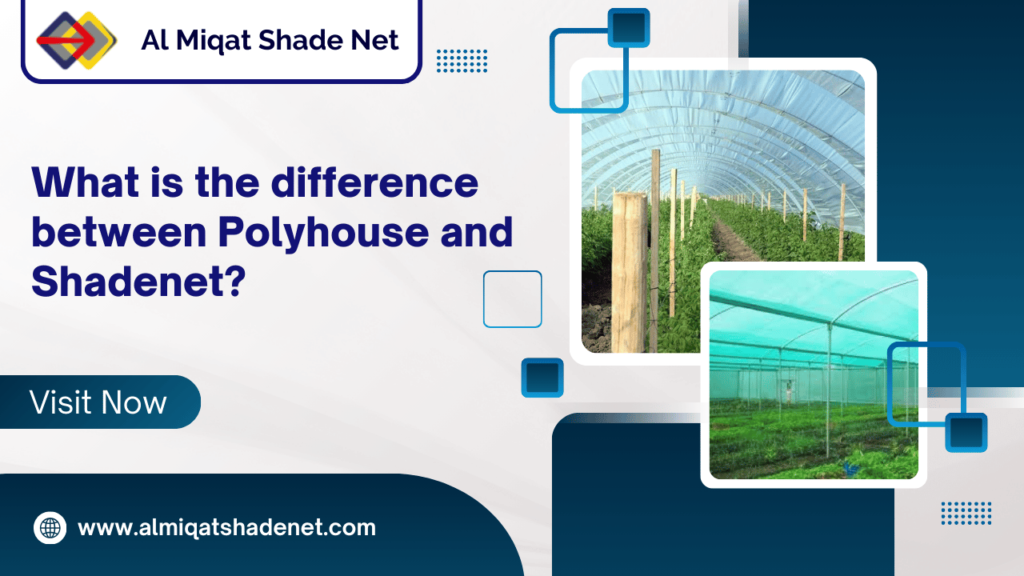In modern agriculture, optimizing growing conditions for crops is essential for high yields and quality produce. Two popular methods for enhancing crop growth are polyhouses and shade nets. While both systems create favorable environments for plants, they have distinct features and benefits. Al Miqat Hardware, the best shade net provider in the UAE, offers high-quality products, including green shade nets, garden shade netting, white shade nets, and greenhouse shade nets. Let’s explore the differences between polyhouses and shade nets to see which might be best for your needs.
Polyhouses: Controlled Environments for High Precision Farming
A polyhouse, also known as a greenhouse, is a structure made of transparent materials like polyethylene or polycarbonate sheets. These structures provide a controlled environment for plants by regulating temperature, humidity, and light. Polyhouses often come with advanced systems like heating, cooling, and ventilation to maintain optimal growing conditions year-round.
Polyhouses extend the growing season, allowing farmers to cultivate crops regardless of external weather. This stability is beneficial for high-value crops like tomatoes, cucumbers, and flowers, which need precise environmental control for optimal growth.
Polyhouses also protect crops from extreme weather events like heavy rains, strong winds, and hailstorms, which can damage crops in open fields. The enclosed environment reduces the risk of pest and disease infestations, minimizing the need for chemical pesticides and promoting sustainable farming practices.
Shade Nets: Versatile and Cost-Effective Solutions
Shade nets, such as those provided by Al Miqat Hardware, offer a different approach to protecting and enhancing crop growth. These nets, available in various types like green shade nets, garden shade netting, white shade nets, and greenhouse shade nets, filter sunlight to create a favorable microclimate for plants. Unlike polyhouses, shade nets do not completely enclose the crops but provide shading to reduce the intensity of direct sunlight.
Shade nets reduce heat stress on plants by filtering sunlight and preventing excessive heat buildup, which can cause wilting and lower crop yields. This feature is crucial in hot climates like the UAE, where high temperatures can severely impact plant health. Green shade nets are popular for general use, while white shade nets are used for specific crops that need more light diffusion.
Garden shade netting offers flexibility and ease of installation. Farmers can set up shade nets over open fields, greenhouses, or home gardens, making them a versatile option for various agricultural practices. This adaptability allows farmers to use shade nets for different crops and growing conditions, optimizing their resources and improving productivity.
Key Differences Between Polyhouses and Shade Nets
While both polyhouses and shade nets aim to improve growing conditions, their differences lie in their structure, function, and cost.
Structure: Polyhouses are fully enclosed with transparent coverings, while shade nets provide partial coverage and shading. Polyhouses require a more complex setup, including frames, coverings, and environmental control systems, whereas shade nets involve a simpler installation process.
Environmental Control: Polyhouses offer precise control over temperature, humidity, and light, making them ideal for crops needing specific growing conditions. Shade nets primarily reduce sunlight intensity and heat, offering a less controlled but still effective environment for many crops.
Cost: Polyhouses typically involve higher initial investments due to their complex structures and systems. Shade nets are a more cost-effective solution, providing significant benefits with lower installation and maintenance costs. This affordability makes shade nets attractive for small to medium-scale farmers.
Flexibility: Shade nets offer greater flexibility in application. They can be used in various settings, from large agricultural fields to small home gardens, and can be easily adjusted or relocated as needed. Polyhouses are more permanent structures, requiring more planning and investment.
Choosing the Right Solution
The choice between polyhouses and shade nets depends on several factors, including the type of crops, climate, and budget. For high-value crops requiring precise environmental control, polyhouses may be the best option. They provide year-round protection and optimal growing conditions, resulting in higher yields and better quality produce.
For crops that can tolerate a more open environment but still need protection from excessive heat and sunlight, shade nets are an excellent choice. Al Miqat Hardware offers a range of high-quality shade nets, including green shade nets, garden shade netting, white shade nets, and greenhouse shade nets, to suit different agricultural needs. These nets are particularly beneficial in hot climates like the UAE, where managing heat stress is crucial for successful crop production.
Conclusion
Understanding the differences between polyhouses and shade nets is essential for making informed decisions in modern farming. Polyhouses offer controlled environments for high precision farming, while shade nets provide versatile and cost-effective solutions for protecting crops from excessive sunlight and heat. Al Miqat Hardware, the leading shade net provider in the UAE, offers a wide range of products, including green shade nets, garden shade netting, white shade nets, and polyhouse shade nets made from high-density polyethylene (HDPE) and other shade cloth materials. By choosing the right solution, farmers can optimize growing conditions, enhance crop yields, and achieve sustainable agricultural success.


